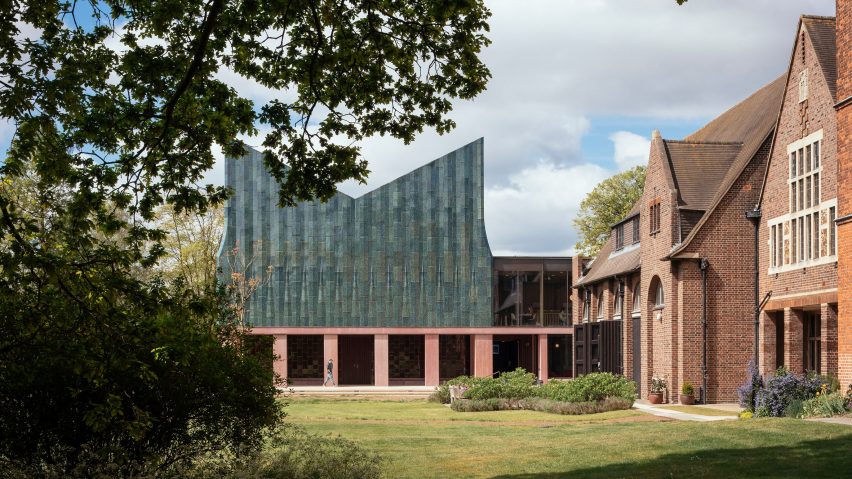London architecture studio Feilden Fowles has completed a timber-framed dining hall at the University of Cambridge's Homerton College with a faience-tiled volume set above a pigmented-concrete colonnade.
Designed to reference the adjacent arts and crafts-style Ibberson Building and the college's Victorian Gothic Revival buildings, the dining hall contains the main eating space along with a smaller room for eating called a buttery, kitchens and staff amenities.
The London-based studio, led by Fergus Feilden and Edmund Fowles, designed the building to replace the previous dining hall and dark, cramped and outdated kitchen facilities at Cambridge's youngest college.
The college moved to the site in 1894 from its original home in east London and occupies several buildings that were constructed in the 1870s for Cavendish College.
"The design of the hall is symbolic of Homerton's progressive character and bold ambitions, yet simultaneously in conversation with the rich architectural heritage of Cambridge," said Feilden Fowles director, Edmund Fowles.
"There are echoes of the marching buttresses of King's College Chapel, references to the Victorian Gothic Revival of Homerton's Cavendish College buildings, and motifs of the neighbouring arts and crafts Ibberson Building," he added.
"They combine as a marker of today's architectural thinking, an embodiment of low-tech principles, an arts and crafts of the 21st century."
The building is designed as a social fulcrum for the college campus, with a series of courtyards and cloisters around its perimeter creating informal spaces for meetings and chance encounters.
The ground floor plinth is constructed from pigmented concrete with columns set out on a three-metre grid that lends a rational and ordered appearance to the elevations.
The building is partially covered with green faience tiles that reference the arts and crafts movement, as well as complementing the red-brick, sandstone, lead and oxidised copper of the college's existing buildings including the Great Hall.
Feilden Fowles worked with architectural ceramics fabricator Darwen Terracotta to develop the 3,200 tiles, which can be found on many Victorian public buildings in Britain.
"The architecture celebrates the integrity and inherent beauty of materials and craftsmanship, where ornamentation is a product of the natural beauty and imperfection of the handmade," the architecture studio added.
"It also embraces new methods of construction and engineering technologies of today, such as the use of parametric modelling to develop the faience facade – an arts and crafts of the 21st century."
The primary internal space is a bright and airy dining hall that recalls traditional ceremonial halls and transforms at night into a dramatic events space with a capacity for up to 336.
The exposed structure comprises a sweet-chestnut laminated-timber frame and butterfly trusses intended to evoke traditional collegiate halls.
The valley-shaped roof provides a modern twist, while details such as the dowelled joints showcase the traditional methods used to erect the prefabricated framework.
Large openings lining the hall at ground-floor level provide a visual connection to the adjacent trees and a meadow on the southern side, while clerestory windows on both sides allows daylight to pour in from above.
The buttery seats up to 60 and serves as a more informal cafe where students can meet to socialise. Quiet study spaces are tucked away on a balcony looking onto the grounds.
Improved back-of-house spaces including kitchens and staff facilities are linked to the dining areas by efficient and functional circulation connections.
These buildings are clad externally with red brick to reference the nearby Ibberson Building. Their offset forms ensure staff benefit from abundant daylight and views to the newly formed western courtyard.
Feilden Fowles was established in 2009 and has gained a reputation for creating buildings that translate historic, cultural or vernacular references into modern schemes featuring bold and expressive structural solutions.
The studio's previous completed projects include the addition of a red sandstone pavilion at the entrance to Carlisle Cathedral and a visitor centre featuring pigmented concrete walls for the Yorkshire Sculpture Park.
The photography is by David Grandorge unless stated. Main image is by Jim Stephenson

